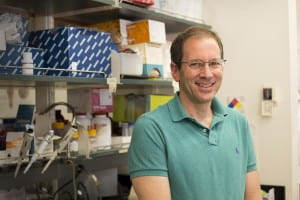Chemistry Olympiad. Quiz Bowl. Math League. Science fairs.
As a high school student, Suhas Gondi could have competed in any of the big academic showdowns. He chose Brain Bee, a neuroscience competition.
“It’s a pretty specific topic, yes. But the brain encompasses so much: chemistry, biology, psychology,†said Gondi, a junior in Arts & Sciences at Washington University in St. Louis. “It really is the final frontier. We’ve been to space, but we still don’t understand fully what’s going on inside of our heads.â€
Gondi and fellow members of Synapse, Washington University’s neuroscience club, are helping local high school students prepare for the annual St. Louis Area Brain Bee Saturday, Feb. 13, at McDonnell Hall on the Danforth Campus. Some 50 local students are expected to compete at the event, with the winner earning a fellowship in a neuroscience laboratory and a trip to the National Brain Bee. The competition is organized by neuroscientist Erik Herzog, PhD, professor of biology in Arts & Sciences and a faculty fellow for the university’s Institute for School Partnership, a booster of STEM education in local schools.

On this day, Gondi and junior Chris Parrino, both neuroscience majors, cover the five senses and degenerative diseases; psychiatric disorders; and speech. They show images of shrunken hippocampi, illustrations of neural pathways and scans of brains altered by cocaine. Parrino stops to ask the students of the causes of addiction.
“Neuropathy,†answers one.
“Genetics,†offers another.
“The answer is we don’t know,†Parrino tells them.
“All of the unknowns are why I’m so interested in neuroscience, and why I hope you are interested too.â€
They are. CeCe Canepa, a senior at nearby St. Joseph’s Academy, plans to study neuropharmacology in college. She is participating in Brain Bee as a way to learn more about the brain’s chemistry and structure. Her friend, Maggie Ahlert, also a St. Joseph’s senior, is considering a career in brain science as well.
“The volunteers have really made this so interesting and so relevant,†Ahlert said. “Almost everything we talk about can be related to someone I know.â€
The nation will need more aspiring neuroscientists like Canepa and Ahlert in order to unravel the brain’s mysteries, says Synapse executive Smruti Rath, also a junior in neuroscience. In 2013, President Barack Obama launched the Brain Initiative to develop better imaging technologies and uncover news ways to prevent and treat brain disorders.
“More and more, students are getting introduced to brain science in high school and it’s fun to share what we know with them,†Rath said. “The Brain Bee is a competition, but it’s not about being competitive.
“It’s about getting more people excited about this fast-growing field.â€
February 2016 | by, Diane Toroian Keaggy
